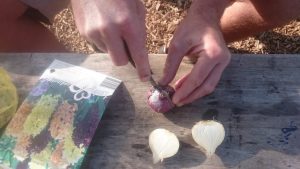I have a dim memory from childhood that bulbs, particularly hyacinth bulbs, can be grafted together. If it really IS possible you’d have thought there would be more about grafting bulbs online… alas, a search turns up very little.
Cut two different colour hyacinth bulbs in half

Join them together
Tape them up

Plant them and wait

The only reference to grafting hyacinth bulbs that I can find online comes, surprisingly, from Charles Darwin’s book Animals and Plants Under Domestication:
“I should not have quoted the following case had not the author of ‘Des Jacinthes’114 impressed me with the belief not only of his extensive knowledge, but of his truthfulness: he says that bulbs of blue and red hyacinths may be cut in two, and that they will grow together and throw up a united stem (and this I have myself seen), with flowers of the two colours on the opposite sides. But the remarkable point is, that flowers are sometimes produced with the two colours blended together, which makes the case closely analogous with that of the blended colours of the grapes on the united vine-branches”
We will keep our fingers crossed here at Sheepskin Towers, hoping for some growth and perhaps even some multi-coloured flowers… I’ll post an update in due course!



Did the grafted hyacinth bulbs work? I’m just about to have a go with my daughter. Apart from the Darwin quote I can find precious little information on-line. Thanks
Ours didn’t work! Each half just withered and nothing grew. Don’t let that put you off, I’d love to know if you get a better result. Good luck!
have you got offsets from the halves?
Hi – unfortunately it seems to be a failed experiment. The whole Hyacinth bulbs are doing really well, with great root growth and good shoots. The pots of half and half bulbs have no noticeable root growth and no shoots. The bulbs haven’t started rotting yet, so we’ll leave them for the time being…
I will try it too, even if i gonna lose the bulbs.
It is now the season of planting bulbs here in Jordan.
Thanks Christopher – they’re all potted-up. I’ll keep you posted…
Cheers, Ivan
I wonder if perhaps the timing of the graft has something to do with it. I’m trying this experiment this year when it comes time to force my hyacinths, but I plan on attempting the graft on dormant bulbs, and then on bulbs that have just barely begun to sprout. And I’ll let you know if I have any luck with either!
I have not tried hyacinths, however am interested in grafting gladiolas. I cannot find any info on this. I however have a memory of an uncle who had a glad farm and grafted the bulbs to make special bulbs. I however was too small to remember anything except the beautiful gladiolas row after row in the garden. Any suggestions. Thought I would just split some and tape them together.
We are in to Amaryllis and I thought I might give it a try. I would try it after the flowers have faded when the bulbs seem to be in a full growth recovery mode, are producing leaves and storing nutrients for the following season. Also I would think the basal plates would have to be tight together to unite.
Tightly pinned together with tooth picks and dusted in cinnamon to seal any open wounds to prevent disease and rot.
Amaryllis reproduce very well from even the smallest part of the basal plate but of course they are only clones.
Having given this more thought, my proposal will not work to produce a new strain, that can only be done by genetic process ( Mendels experiments with peas ) I have done grafting of fruit trees but the result is not a new strain, simply the scion being fed by the root system of another plant of the same species. ( Kidney transplants in humans )